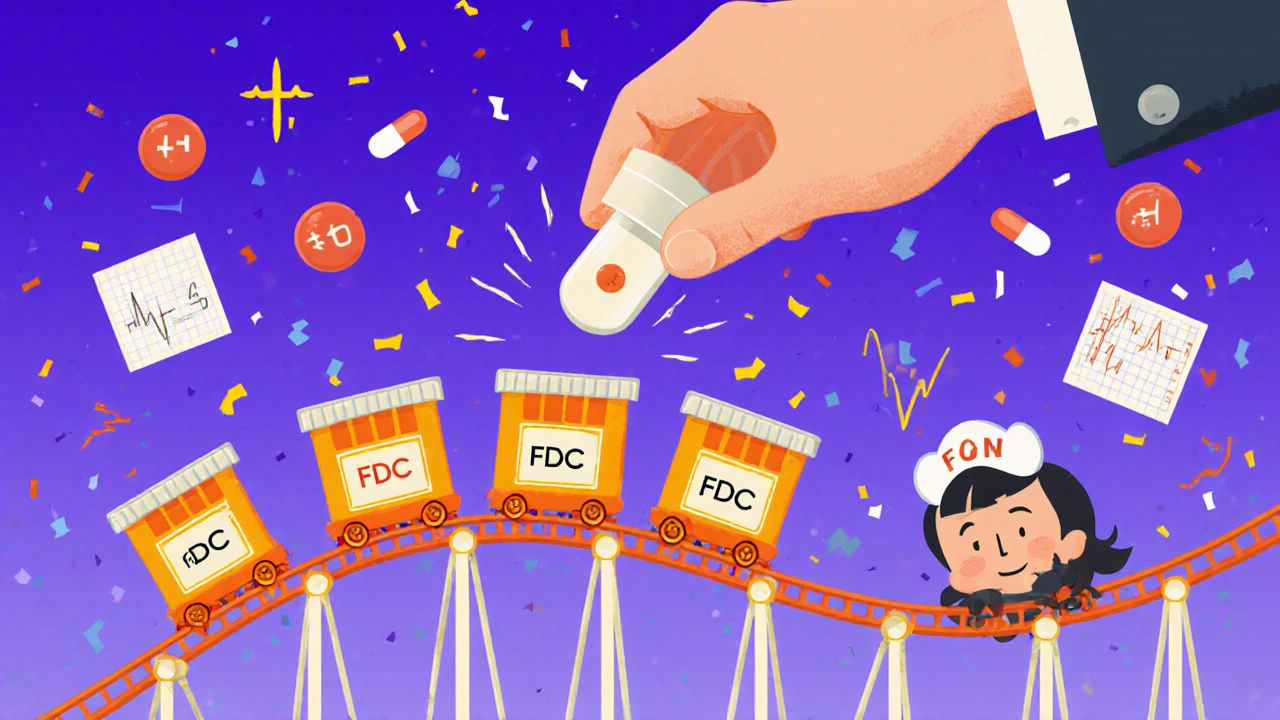What exactly are fixed-dose combination drugs?
Fixed-dose combination drugs are pharmaceutical products that combine two or more active ingredients into a single tablet, capsule, or other dosage form, with each ingredient locked at a fixed amount. Unlike taking separate pills, you get everything in one dose-no mixing, no counting, no confusion.
Think of it like a pre-made smoothie: instead of buying banana, spinach, and protein powder separately and mixing them yourself, you buy a ready-blended bottle. That’s what FDCs do for medications. The most common examples include pills that combine blood pressure drugs like lisinopril and hydrochlorothiazide, or diabetes medications like metformin and sitagliptin.
These combinations aren’t random. They’re designed based on clinical evidence showing that the drugs work better together-either because they target different parts of the same disease, or because one drug helps reduce side effects of the other. For instance, levodopa and carbidopa are paired so that carbidopa stops levodopa from breaking down too early in the body, letting more of it reach the brain to treat Parkinson’s symptoms.
Why did these combinations even become a thing?
The main reason? Simplicity. Taking multiple pills every day is hard. People forget. They get overwhelmed. They stop. And when they stop, their condition gets worse.
Back in the 1990s, when HIV treatment required patients to swallow 15-20 pills a day, adherence rates were terrible. Then came the first major FDCs for HIV-like Combivir (zidovudine + lamivudine)-which cut that down to one or two pills. Suddenly, people could stick to their treatment. Survival rates jumped. That’s when the medical world realized: reducing pill burden isn’t just convenient. It saves lives.
Since then, FDCs have spread to other chronic conditions. High blood pressure, tuberculosis, asthma, epilepsy, and even depression now have common FDC options. The World Health Organization has included over 20 fixed-dose combinations in its Model List of Essential Medicines because they’ve proven to be more effective and accessible in real-world settings.
What’s the science behind choosing which drugs go together?
Not every two drugs that work well on their own should be mixed. There are strict rules.
The World Health Organization laid out three key criteria for a rational FDC:
- The drugs must work through different mechanisms (like one blocking inflammation and another reducing pain).
- They need to last about the same amount of time in the body-so they can be taken together without one wearing off too fast.
- The combination shouldn’t make side effects worse than if you took them separately.
For example, sulfamethoxazole and trimethoprim are paired because they attack bacteria in two different ways. Together, they’re more powerful than either alone. But if you tried to combine a drug that causes drowsiness with another that causes insomnia, it wouldn’t make sense. The body would be pulled in opposite directions.
Regulators like the FDA and EMA require proof that each drug in the combo actually contributes to the benefit. You can’t just slap two old drugs together and call it innovation. There has to be data showing the combination does something better than the individual parts.

Do FDCs really improve how people take their meds?
Yes-when they’re done right.
A study tracking patients on HIV treatment found that switching from three separate pills to one FDC increased adherence from 68% to 89%. Similar results showed up in hypertension patients: those on FDCs were 30% more likely to stick to their regimen over a year than those taking the same drugs separately.
It’s not just about remembering to take pills. It’s about cost and time too. FDCs mean fewer pharmacy trips, fewer co-pays, and less confusion about which pill to take when. One analysis found that replacing three separate medications with a single FDC could save patients up to $500 a year in out-of-pocket costs.
But here’s the catch: this only works if the FDC matches the patient’s needs. If someone needs to lower their blood pressure a little more but can’t handle more of the diuretic in the combo, they’re stuck. That’s the downside.
What are the downsides of fixed-dose combinations?
The biggest problem? Rigidity.
Once you’re on a fixed-dose combo, you can’t adjust one drug without changing the whole pill. If your kidney function changes and you need less of one component, you might have to switch back to separate pills-or worse, stop the whole treatment.
Another issue: side effects. If one drug causes nausea and the other causes dizziness, you now get both at the same time. That’s harder to manage than adjusting one drug at a time.
And then there’s the industry problem. Some companies develop FDCs not because they’re clinically better, but because their patent on a popular drug is about to expire. By combining it with another drug-sometimes even an old, cheap one-they get a new patent and delay generic competition. Regulators call this “lifecycle management.” Patients and insurers call it gaming the system.
That’s why not all FDCs get approved. The FDA and WHO screen them carefully. Only about half of the FDCs submitted for approval actually make it through because they fail to prove they’re truly better than taking the drugs separately.
Where are FDCs most commonly used today?
Cardiovascular disease leads the pack. Over 40% of all FDCs on the market target high blood pressure, cholesterol, or heart failure. Why? Because these conditions need multiple drugs to control, and patients often take them for life. A single pill that combines an ACE inhibitor, a calcium blocker, and a statin? That’s a game-changer.
Dermatology is another big area. Acne treatments like clindamycin + benzoyl peroxide come in one gel. Psoriasis has FDCs combining corticosteroids with vitamin D analogs. These work better together than separately, and applying one product instead of two makes daily use much easier.
Antibiotics are another success story. Tuberculosis treatment has relied on FDCs for decades-rifampicin + isoniazid + pyrazinamide in one tablet. It’s simple, cheap, and prevents patients from skipping doses, which is how drug-resistant TB spreads.
And now, we’re seeing FDCs enter new areas: Parkinson’s, epilepsy, and even mental health. There’s growing interest in combining antidepressants with drugs that reduce inflammation, since brain inflammation is now linked to depression.

How are these drugs approved, and who makes sure they’re safe?
The approval process is tougher than for single drugs.
If both ingredients are already approved separately, companies can use the FDA’s 505(b)(2) pathway. This lets them rely on existing safety data-but they still need to prove the combination works as intended. That means clinical trials showing the fixed ratio is effective and safe.
For example, if a new FDC combines two blood pressure drugs, the company must show that the specific doses in the pill lower blood pressure better than each drug alone, or at least as well, with no unexpected side effects.
Regulators also demand pharmacokinetic studies: Do both drugs get absorbed at the same rate? Do they stay in the body long enough to work together? If one drug is absorbed quickly and the other slowly, the combo won’t work right.
The European Medicines Agency and FDA both require Phase 2 and 3 trials for most new FDCs-even if the individual drugs are old. That’s because combinations behave differently than single agents. You can’t assume safety by default.
What does the future hold for fixed-dose combinations?
The future is more complex, more targeted, and more regulated.
Scientists are now designing FDCs for cancer, Alzheimer’s, and autoimmune diseases where multiple pathways need to be hit at once. For example, combining a drug that blocks tumor growth with one that boosts the immune system’s attack on cancer cells.
But here’s the twist: future FDCs won’t just be one-size-fits-all. New technologies are making it possible to create FDCs with delayed-release layers, so one drug kicks in right away and the other slowly over time. Or even smart pills that release different doses depending on the patient’s needs.
Meanwhile, payers and regulators are getting smarter. Insurance companies now demand real-world data-not just lab results-to prove FDCs improve outcomes, reduce hospital visits, or cut long-term costs. If a combo doesn’t deliver that, it won’t get covered.
And the WHO? They’re expanding their list of recommended FDCs every year, but they’re also cracking down on irrational ones. In 2023, they removed several combinations that offered no real benefit over separate drugs.
The message is clear: FDCs aren’t just about convenience. They’re about smarter, safer, more effective care-if they’re built the right way.
Should you ask your doctor about FDCs?
If you’re taking two or more pills daily for the same condition, yes.
Ask: “Is there a fixed-dose combination available for my medications?”
Then ask: “Does this combo actually work better than taking them separately-or is it just a new patent?”
Don’t assume it’s better just because it’s one pill. Make sure it matches your needs. If your dose changes often, or you have kidney or liver issues, a fixed combo might not be the best fit.
But if you’re stable, taking the same doses for months, and struggling to keep up with your pillbox? An FDC could be a simple fix that changes your whole routine.
 Nov, 17 2025
Nov, 17 2025
